Teaching Methodology for Understanding Virtual Reality and Application Development in Engineering Major
Abstract
1. Introduction
2. Literature
3. Methodology
3.1. Step 1: Introductory Theory and Method
3.2. Step 2: Content Creation Training by Teaching Assistant
3.3. Step 3: Team Project-Based Learning
4. Results
4.1. Questionnaires
4.2. Discussion
4.3. In-Depth Interview
4.4. Course Redesign
5. Limitations and Future Work
6. Conclusions
Author Contributions
Funding
Institutional Review Board Statement
Informed Consent Statement
Data Availability Statement
Conflicts of Interest
References
- Tabuenca, B.; Serrano-Iglesias, S.; Martin, A.C.; Villa-Torrano, C.; Dimitriadis, Y.; Asensio-Pérez, J.I.; Alario-Hoyos, C.; Gomez- Sanchez, E.; Bote-Lorenzo, M.L.; Martinez-Mones, A. Affordances and core functions of smart learning environments: A systematic literature review. IEEE Trans. Learn. Technol. 2021, 14, 129–145. [Google Scholar] [CrossRef]
- Serrano, D.R.; Dea-Ayuela, M.A.; Gonzalez-Burgos, E.; Serrano-Gil, A.; Lalatsa, A. Technology-enhanced learning in higher education: How to enhance student engagement through blended learning. Eur. J. Educ. 2019, 54, 273–286. [Google Scholar]
- Kim, J.; won Oh, S.; Choi, J.; Park, S.; Kim, W. Optical see-through head-mounted display including transmittance-variable display for high visibility. J. Inf. Disp. 2022, 23, 121–127. [Google Scholar]
- Pellas, N.; Dengel, A.; Christopoulos, A. A scoping review of immersive virtual reality in STEM education. IEEE Trans. Learn. Technol. 2020, 13, 748–761. [Google Scholar] [CrossRef]
- Wolfartsberger, J. Analyzing the potential of Virtual Reality for engineering design review. Autom. Constr. 2019, 104, 27–37. [Google Scholar]
- Southgate, E.; Smith, S.P.; Cividino, C.; Saxby, S.; Kilham, J.; Eather, G.; Scevak, J.; Summerville, D.; Buchanan, R.; Bergin, C. Embedding immersive virtual reality in classrooms: Ethical, organisational and educational lessons in bridging research and practice. Int. J. Child-Comput. Interact. 2019, 19, 19–29. [Google Scholar]
- Schmidt, M.; Schmidt, C.; Glaser, N.; Beck, D.; Lim, M.; Palmer, H. Evaluation of a spherical video-based virtual reality intervention designed to teach adaptive skills for adults with autism: A preliminary report. Interact. Learn. Environ. 2021, 29, 345–364. [Google Scholar] [CrossRef]
- Rousell, D. Walking with media: Towards a mixed reality pedagogy in university learning environments. In People Personal Data and the Built Environment; Springer: Berlin/Heidelberg, Germany, 2019; pp. 205–229. [Google Scholar]
- Luka, Ž; Kaštelan, I.; Vranješ, M.; Todorovic’, B.M. AMV ALPHA Learning Platform for Automotive Embedded Software Engineering. IEEE Trans. Learn. Technol. 2021, 14, 292–298. [Google Scholar]
- Cabrera, I.; Villalon, J.; Chavez, J. Blending communities and team-based learning in a programming course. IEEE Trans. Educ. 2017, 60, 288–295. [Google Scholar] [CrossRef]
- Salah, B.; Abidi, M.H.; Mian, S.H.; Krid, M.; Alkhalefah, H.; Abdo, A. Virtual reality-based engineering education to enhancemanufacturing sustainability in industry 4.0. Sustainability 2019, 11, 1477. [Google Scholar] [CrossRef]
- Song, G.; Wang, C.; Nie, Y.; Chen, G. Research of the Course Design based on Project-Based Learning for College Computer Major. In Proceedings of the 2020 International Conference on Big Data and Informatization Education (ICBDIE), Zhangjiajie, China, 23–25 April 2020; pp. 435–439. [Google Scholar]
- Lee, M.J.; Nikolic, S.; Vial, P.J.; Ritz, C.H.; Li, W.; Goldfinch, T. Enhancing project-based learning through student and industry engagement in a video-augmented 3-D virtual trade fair. IEEE Trans. Educ. 2016, 59, 290–298. [Google Scholar] [CrossRef]
- Dalgarno, B.; Gregory, S.; Carlson, L.; Lee, M.J.; Tynan, B. A Systematic Review and Environmental Analysis of the Use of 3D Immersive Virtual Worlds in Australian and New Zealand Higher Education Institutions: Final Report 2013. 2013. Available online: https://researchoutput.csu.edu.au/ws/portalfiles/portal/9387856/55639_Report (accessed on 22 December 2022).
- Murray, J.A.; Littleton, F.; Dozier, M. Use and Perception of Second Life by Distance Learners: The Effects of Orientation Session Timing. 2015. Available online: https://www.ijede.ca/index.php/jde/article/view/898/1577 (accessed on 22 December 2022).
- Hosseinzadeh, N.; Hesamzadeh, M.R. Application of project-based learning (PBL) to the teaching of electrical power systems engineering. IEEE Trans. Educ. 2012, 55, 495–501. [Google Scholar] [CrossRef]
- Gary, K. Project-based learning. Computer 2015, 48, 98–100. [Google Scholar] [CrossRef]
- Macias, J.A. Enhancing project-based learning in software engineering lab teaching through an e-portfolio approach. IEEE Trans. Educ. 2012, 55, 502–507. [Google Scholar] [CrossRef]
- Barak, M.; Pearlman-Avnion, S. Who will teach an integrated program for science and technology in Israeli junior high schools? A case study. J. Res. Sci. Teach. Off. J. Natl. Assoc. Res. Sci. Teach. 1999, 36, 239–253. [Google Scholar] [CrossRef]
- Prince, M.J.; Felder, R.M. Inductive teaching and learning methods: Definitions, comparisons, and research bases. J. Eng. Educ. 2006, 95, 123–138. [Google Scholar] [CrossRef]
- Dym, C.L.; Agogino, A.M.; Eris, O.; Frey, D.D.; Leifer, L.J. Engineering design thinking, teaching, and learning. J. Eng. Educ. 2005, 94, 103–120. [Google Scholar] [CrossRef]
- Graham, R. UK Approaches to Engineering Project-Based Learning. White Paper Sponsored by the Bernard M. Gordon/MIT Engineering Leadership Program. 2010. Available online: https://www.rhgraham.org/resources/MIT-White-Paper---UK-PjBL-April-2010.pdf (accessed on 22 December 2022).
- Mills, J.E.; Treagust, D.F. Engineering education—Is problem-based or project-based learning the answer. Australas. J. Eng. Educ. 2003, 3, 2–16. [Google Scholar]
- Perrenet, J.C.; Bouhuijs, P.A.; Smits, J.G. The suitability of problem-based learning for engineering education: Theory and practice. Teach. High. Educ. 2000, 5, 345–358. [Google Scholar] [CrossRef]
- Sánchez-Romero, J.L.; Jimeno-Morenilla, A.; Pertegal-Felices, M.L.; Mora-Mora, H. Design and application of Project-based Learning Methodologies for small groups within Computer Fundamentals subjects. IEEE Access 2019, 7, 12456–12466. [Google Scholar] [CrossRef]
- Fioravanti, M.L.; Sena, B.; Paschoal, L.N.; Silva, L.R.; Allian, A.P.; Nakagawa, E.Y.; Souza, S.R.; Isotani, S.; Barbosa, E.F. Integrating project based learning and project management for software engineering teaching: An experience report. In Proceedings of the 49th ACM Technical Symposium on Computer Science Education, Baltimore, MD, USA, 21–24 February 2018; pp. 806–811. [Google Scholar]
- Sabag, N.; Doppelt, Y. Methodology of change assimilation in technology education—A case study. IEEE Trans. Educ. 2011, 55, 190–195. [Google Scholar] [CrossRef]
- Vergara, D.; Extremera, J.; Rubio, M.P.; Dávila, L.P. The proliferation of virtual laboratories in educational fields. ADCAIJ Adv. Distrib. Comput. Artif. Intell. J. 2020, 9, 85. [Google Scholar] [CrossRef]
- Burnett, G.; Kay, R.P.; Harvey, C. Future Visions for Higher Education: An Investigation of the Benefits of Virtual Reality for Teaching University Students. In Proceedings of the 2021 IEEE International Symposium on Mixed and Augmented Reality Adjunct (ISMAR-Adjunct), Bari, Italy, 4–8 October 2021; pp. 292–297. [Google Scholar]
- Halabi, O. Immersive virtual reality to enforce teaching in engineering education. Multimed. Tools Appl. 2020, 79, 2987–3004. [Google Scholar] [CrossRef]
- Lee, E.A.L.; Wong, K.W.; Fung, C.C. How does desktop virtual reality enhance learning outcomes? A structural equation modeling approach. Comput. Educ. 2010, 55, 1424–1442. [Google Scholar]
- Vergara, D.; Extremera, J.; Rubio, M.P.; Dávila, L.P. Meaningful learning through virtual reality learning environments: A case study in materials engineering. Appl. Sci. 2019, 9, 4625. [Google Scholar] [CrossRef]
- Papanastasiou, G.; Drigas, A.; Skianis, C.; Lytras, M.; Papanastasiou, E. Virtual and augmented reality effects on K-12, higher and tertiary education students’ twenty-first century skills. Virtual Real. 2019, 23, 425–436. [Google Scholar] [CrossRef]
- Vesisenaho, M.; Juntunen, M.; Johanna, P.; Fagerlund, J.; Miakush, I.; Parviainen, T. Virtual reality in education: Focus on the role of emotions and physiological reactivity. J. Virtual Worlds Res. 2019, 12. [Google Scholar] [CrossRef]
- Makransky, G.; Wismer, P.; Mayer, R.E. A gender matching effect in learning with pedagogical agents in an immersive virtual reality science simulation. J. Comput. Assist. Learn. 2019, 35, 349–358. [Google Scholar] [CrossRef]
- Makransky, G.; Borre-Gude, S.; Mayer, R.E. Motivational and cognitive benefits of training in immersive virtual reality based on multiple assessments. J. Comput. Assist. Learn. 2019, 35, 691–707. [Google Scholar] [CrossRef]
- Chai, H.; Priestley, M.; Tang, X.; Ravishankar, J. Implementation of microgrid virtual laboratory in a design course in electrical engineering. In Proceedings of the 2020 IEEE International Conference on Teaching, Assessment, and Learning for Engineering (TALE), Takamatsu, Japan, 8–11 December 2020; pp. 509–515. [Google Scholar]
- Pirker, J.; Dengel, A.; Holly, M.; Safikhani, S. Virtual reality in computer science education: A systematic review. In Proceedings of the 26th ACM Symposium on Virtual Reality Software and Technology, Virtual Event, 1–4 November 2020; pp. 1–8. [Google Scholar]
- Ma, J.; Jaradat, R.; Ashour, O.; Hamilton, M.; Jones, P.; Dayarathna, V.L. Efficacy investigation of virtual reality teaching module in manufacturing system design course. J. Mech. Des. 2019, 141, 13. [Google Scholar] [CrossRef]
- Gunn, T.; Jones, L.; Bridge, P.; Rowntree, P.; Nissen, L. The use of virtual reality simulation to improve technical skill in the undergraduate medical imaging student. Interact. Learn. Environ. 2018, 26, 613–620. [Google Scholar] [CrossRef]
- O’Connor, M.; Stowe, J.; Potocnik, J.; Giannotti, N.; Murphy, S.; Rainford, L. 3D virtual reality simulation in radiography education: The students’ experience. Radiography 2021, 27, 208–214. [Google Scholar] [CrossRef] [PubMed]
- Alhalabi, W. Virtual reality systems enhance students’ achievements in engineering education. Behav. Inf. Technol. 2016, 35, 919–925. [Google Scholar] [CrossRef]
- Jensen, L.; Konradsen, F. A review of the use of virtual reality head-mounted displays in education and training. Educ. Inf. Technol. 2017, 23, 1515–1529. [Google Scholar] [CrossRef]
- Wang, L. Application of virtual reality technique in the construction of modular teaching resources. Int. J. Emerg. Technol. Learn. (Ijet) 2020, 15, 126–139. [Google Scholar] [CrossRef]
- Häfner, P.; Häfner, V.; Ovtcharova, J. Teaching Methodology for Virtual Reality Practical Course in Engineering Education. Procedia Comput. Sci. 2013, 25, 251–260. [Google Scholar] [CrossRef]
- Vergara, D.; Rubio, M.P.; Lorenzo, M. On the design of virtual reality learning environments in engineering. Multimodal Technol. Interact. 2017, 1, 11. [Google Scholar] [CrossRef]
- Pantelidis, V.S. Virtual reality and engineering education. Comput. Appl. Eng. Educ. 1997, 5, 3–12. [Google Scholar] [CrossRef]
- Kamin´ska, D.; Sapin´ski, T.; Wiak, S.; Tikk, T.; Haamer, R.E.; Avots, E.; Helmi, A.; Ozcinar, C.; Anbarjafari, G. Virtual reality and its applications in education: Survey. Information 2019, 10, 318. [Google Scholar] [CrossRef]
- Caeiro-Rodríguez, M.; Manso-Vázquez, M.; Mikic-Fonte, F.A.; Llamas-Nistal, M.; Fernández-Iglesias, M.J.; Tsalapatas, H.; Heidmann, O.; Carvalho, C.V.D.; Jesmin, T.; Terasmaa, J. Teaching soft skills in engineering education: An European perspective. IEEE Access 2021, 9, 29222–29242. [Google Scholar] [CrossRef]
- Hickman, L.; Akdere, M. Exploring virtual reality for developing soft-skills in STEM education. In Proceedings of the 2017 7th World Engineering 724 Education Forum (WEEF), Kuala Lumpur, Malaysia, 13–16 November 2017; pp. 461–465. [Google Scholar]
- Pinzón-Cristancho, B.; Calderón-Torres, H.A.; Mejía-Moncayo, C.; Rojas, A.E. An educational strategy based on virtual reality and QFD to develop soft skills in engineering students. In Workshop on Engineering Applications; Springer: Berlin/Heidelberg, Germany, 2019; pp. 89–100. [Google Scholar]
- O’Connell, R.M. Adapting Team-Based Learning for Application in the Basic Electric Circuit Theory Sequence. IEEE Trans. Educ. 2015, 58, 90–97. [Google Scholar] [CrossRef]
- Michaelsen, L.K.; Sweet, M. The essential elements of team-based learning. New Dir. Teach. Learn. 2008, 2008, 7–27. [Google Scholar] [CrossRef]
- Oldland, E.; Allen, J.; Currey, J. Students’ perception of the role of team-based learning in shaping individual learning style, team skills and clinical practice. Aust. Crit. Care 2016, 29, 117. [Google Scholar] [CrossRef]
- Emke, A.R.; Butler, A.C.; Larsen, D.P. Effects of Team-Based Learning on short-term and long-term retention of factual knowledge. Med. Teach. 2016, 38, 306–311. [Google Scholar] [CrossRef]
- Vasan, N.S.; DeFouw, D.O.; Compton, S. A survey of student perceptions of team-based learning in anatomy curriculum: Favorable views unrelated to grades. Anat. Sci. Educ. 2009, 2, 150–155. [Google Scholar] [CrossRef] [PubMed]
- Anwar, K.; Shaikh, A.A.; Dash, N.R.; Khurshid, S. Comparing the efficacy of team based learning strategies in a problem based learning curriculum. Apmis 2012, 120, 718–723. [Google Scholar] [CrossRef] [PubMed]
- Letassy, N.A.; Fugate, S.E.; Medina, M.S.; Stroup, J.S.; Britton, M.L. Using team-based learning in an endocrine module taught across two campuses. Am. J. Pharm. Educ. 2008, 72, 103. [Google Scholar] [CrossRef]
- Kim, J.; Kim, K.; Kim, W. Impact of Immersive Virtual Reality Content Using 360-degree Videos in Undergraduate Education. IEEE Trans. Learn. Technol. 2022, 15, 137–149. [Google Scholar] [CrossRef]
- Georgiou, Y.; Kyza, E.A. The development and validation of the ARI questionnaire: An instrument for measuring immersion in location-based augmented reality settings. Int. J. Hum. Comput. Stud. 2017, 98, 24–37. [Google Scholar] [CrossRef]
- Cheng, M.T.; She, H.C.; Annetta, L.A. Game immersion experience: Its hierarchical structure and impact on game-based science learning. J. Comput. Assist. Learn. 2015, 31, 232–253. [Google Scholar] [CrossRef]
- Brockmyer, J.H.; Fox, C.M.; Curtiss, K.A.; McBroom, E.; Burkhart, K.M.; Pidruzny, J.N. The development of the Game Engagement Questionnaire: A measure of engagement in video game-playing. J. Exp. Soc. Psychol. 2009, 45, 624–634. [Google Scholar] [CrossRef]
- McAuley, E.; Duncan, T.; Vance, V. Tammen. Psychometric Properties of the Intrinsic Motivation Inventory in a Competitive Sport Setting: A Confirmatory Factor Analysis. Res. Q. Exerc. Sport 1989, 60, 48–58. [Google Scholar] [CrossRef]
- Yaman, M.; Nerdel, C.; Bayrhuber, H. The effects of instructional support and learner interests when learning using computer simulations. Comput. Educ. 2008, 51, 1784–1794. [Google Scholar] [CrossRef]
- Antonietti, A.; Rasi, C.; Imperio, E.; Sacco, M. The representation of virtual reality in education. Educ. Inf. Technol. 2000, 5, 317–327. [Google Scholar] [CrossRef]
- Alavi, M.; Marakas, G.M.; Yoo, Y. A Comparative Study of Distributed Learning Environments on Learning Outcomes. Inf. Syst. Res. 2002, 13, 404–415. [Google Scholar] [CrossRef]
- Khan, M.A.; Vivek, V.; Nabi, M.K.; Khojah, M.; Tahir, M. Students’ perception towards e-learning during COVID-19 pandemic in India: An empirical study. Sustainability 2021, 13, 57. [Google Scholar] [CrossRef]
- Mlekus, L.; Bentler, D.; Paruzel, A. How to raise technology acceptance: User experience characteristics as technology-inherent determinants. Gruppe. Interaktion. Organ. 2020, 51, 273–283. [Google Scholar] [CrossRef]
- El-Sayad, G.; Saad, N.H.M.; Thurasamy, R. How higher education students in Egypt perceived online learning engagement and satisfaction during the COVID-19 pandemic. J. Comput. Educ. 2021, 8, 527–550. [Google Scholar] [CrossRef]
- Brown, A.L. Design Experiments: Theoretical and Methodological Challenges in Creating Complex Interventions in Classroom Settings. J. Learn. Sci. 1992, 2, 141–178. [Google Scholar] [CrossRef]
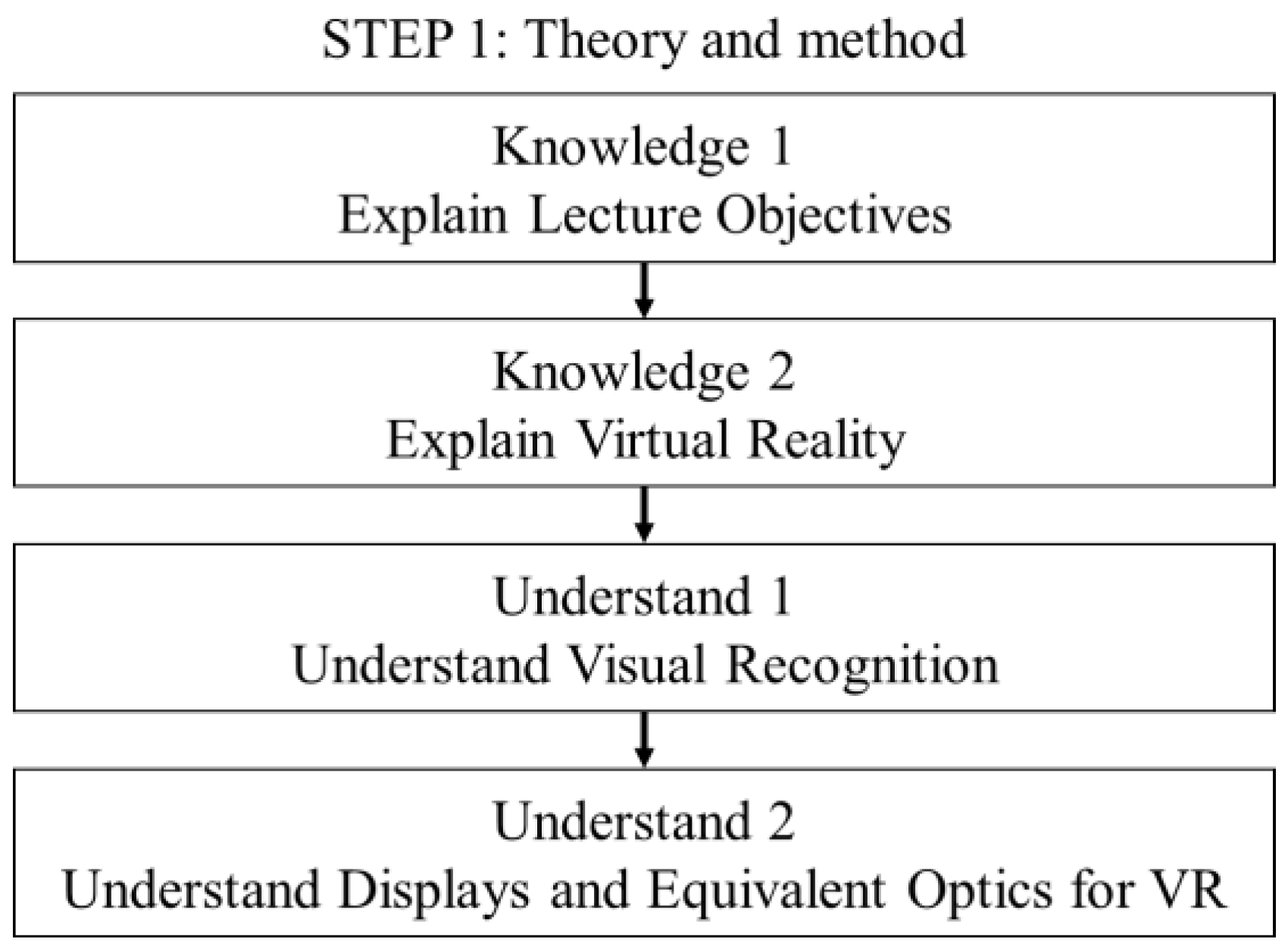
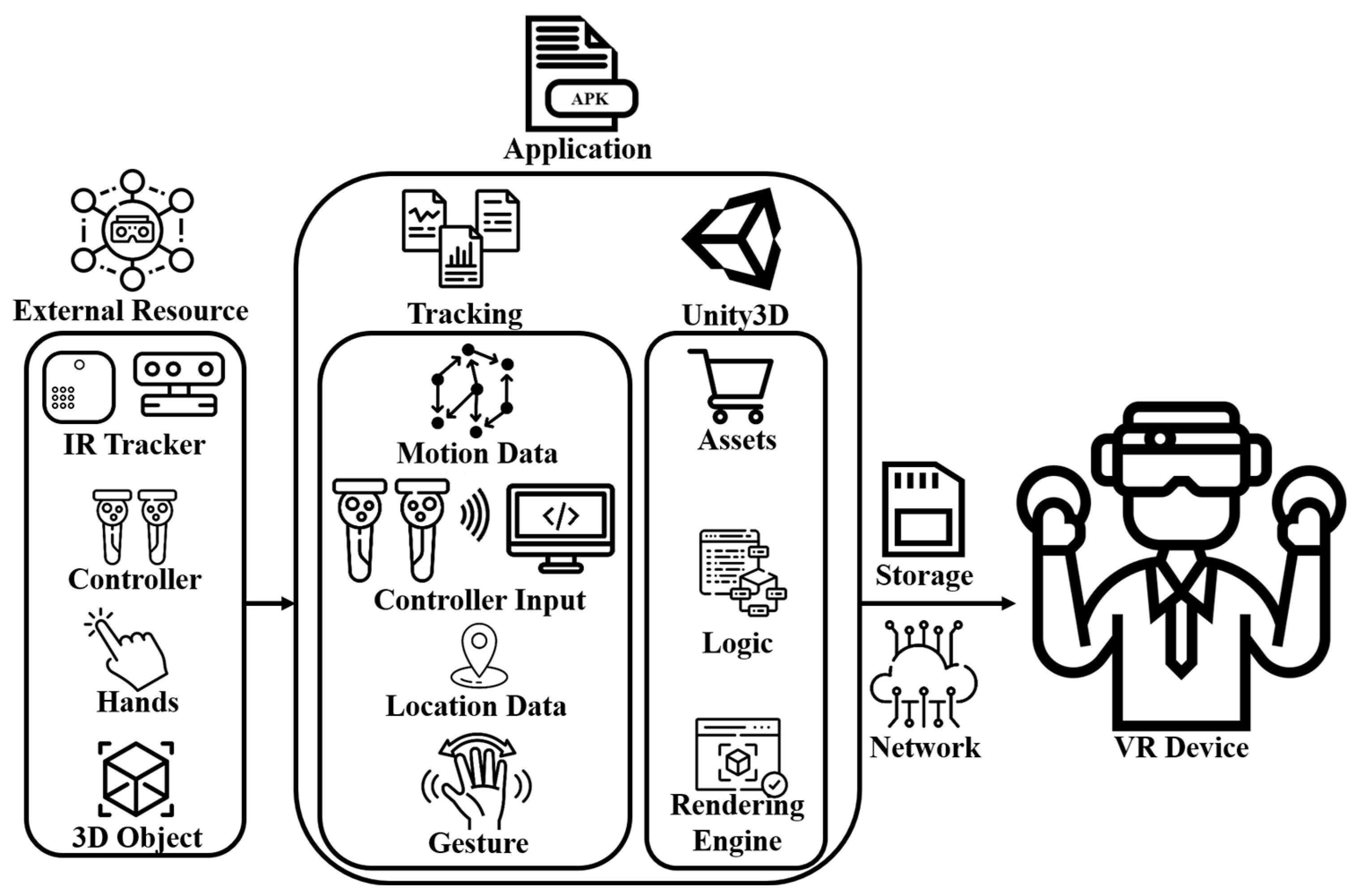
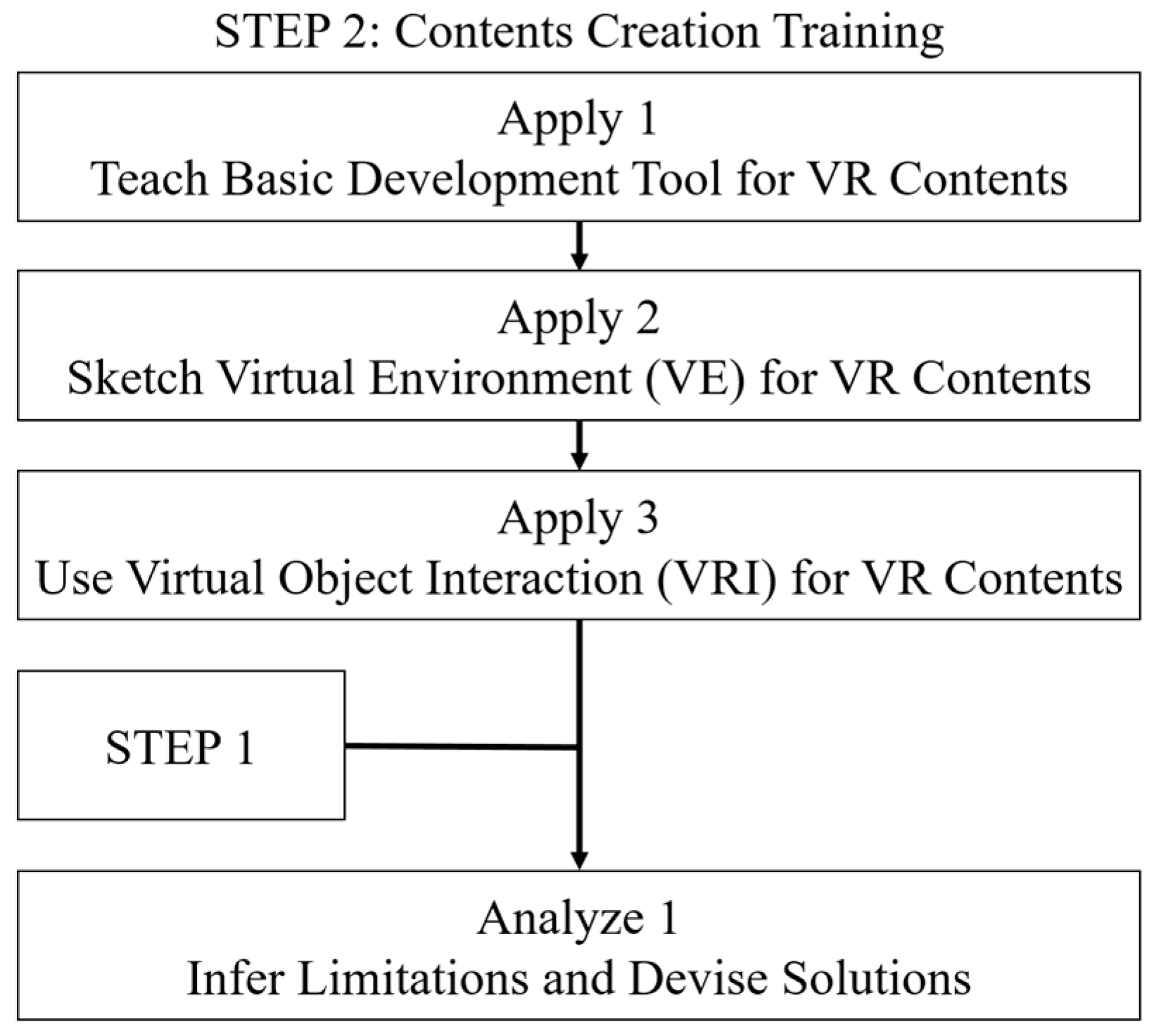
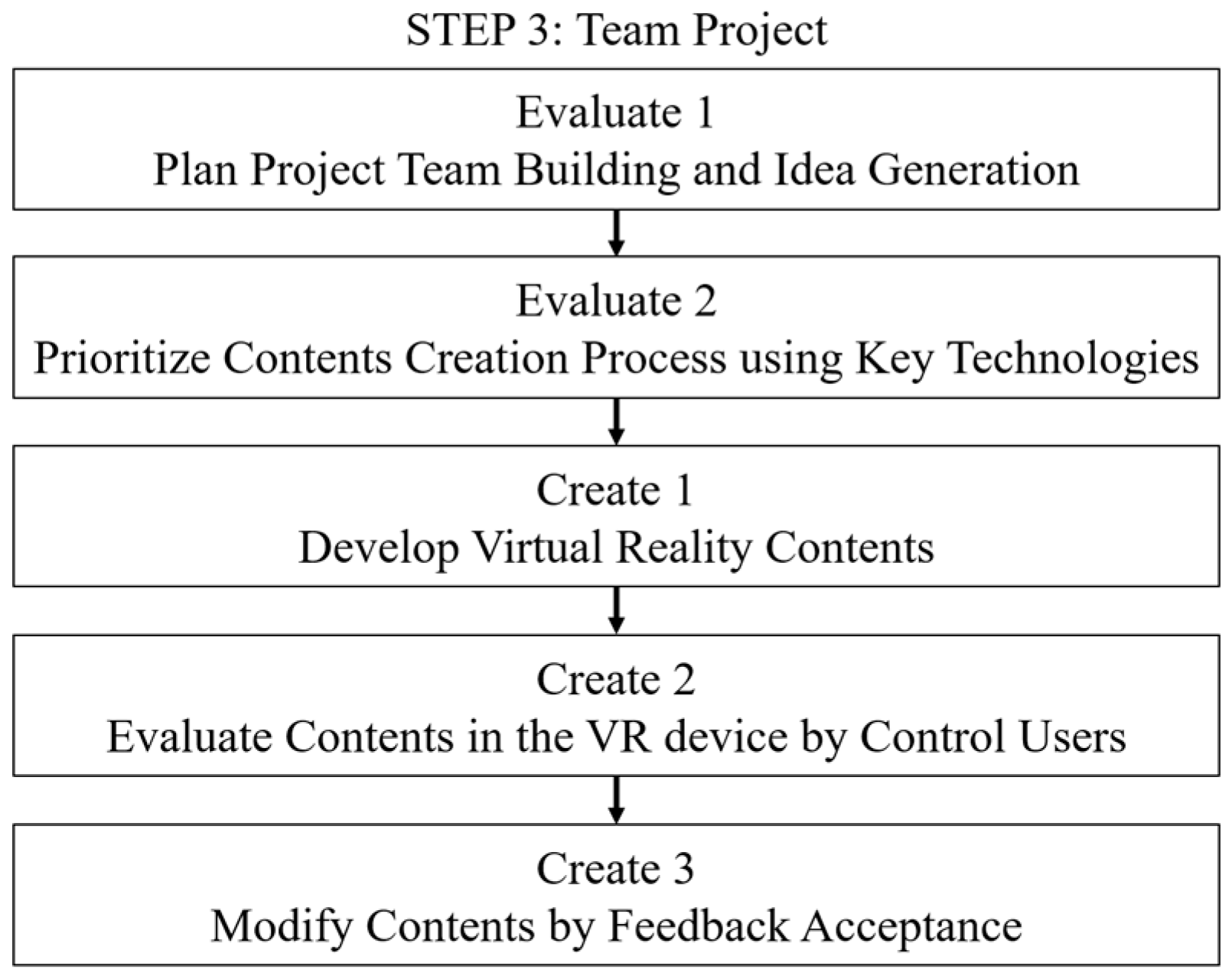

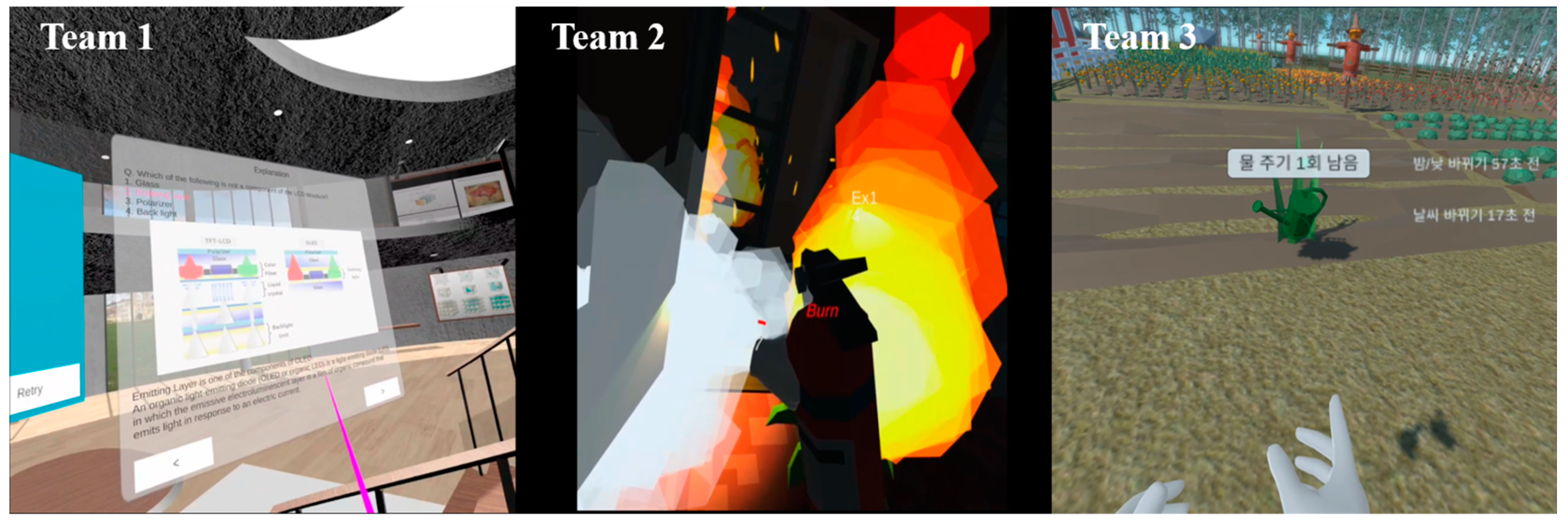
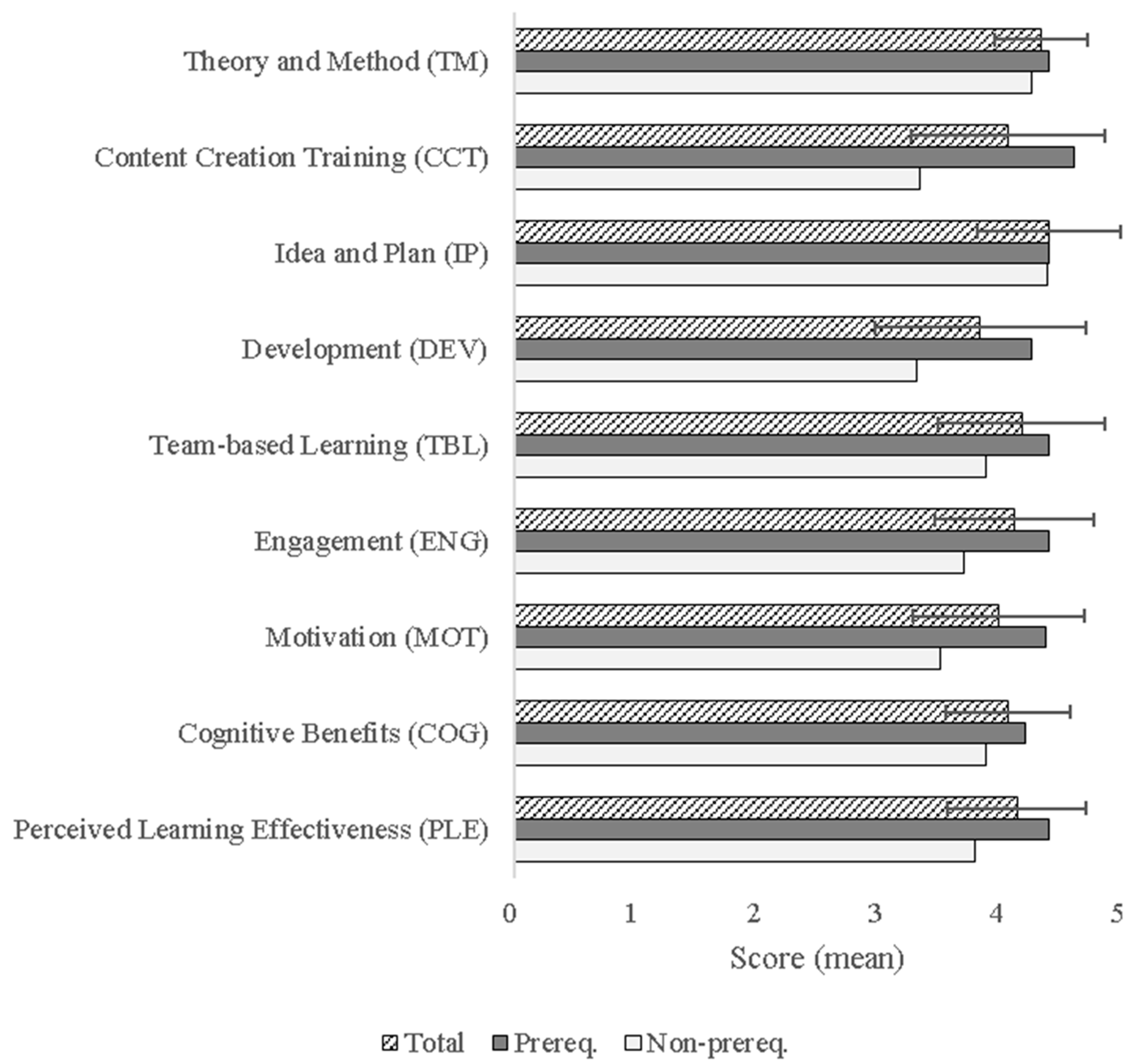

| Student | A | B | C | D | E | F | G | H | I |
|---|---|---|---|---|---|---|---|---|---|
| Prerequisite | O | O | O | O | O | X | X | X | X |
| Experience | O | O | O | O | O | X | O | O | X |
| Category | Questionnaire |
|---|---|
| Theory and Method (TM) |
|
| Content Creation Training (CCT) |
|
| Idea and Plan (IP) |
|
| Development (DEV) |
|
| Team-based Learning (TBL) |
|
| Engagement (ENG) |
|
| Motivation (MOT) |
|
| Cognitive Benefits (COG) |
|
| Perceived Learning Effectiveness (PLE) |
|
| Category | TM | CCT | IP | DEV | TBL | ENG | MOT | COG | PLE |
|---|---|---|---|---|---|---|---|---|---|
| Prerequisites | 4.40 | 4.60 | 4.40 | 4.25 | 4.40 | 4.40 | 4.37 | 4.20 | 4.40 |
| Non-Prerequisites | 4.25 | 3.33 | 4.38 | 3.31 | 3.88 | 3.70 | 3.50 | 3.88 | 3.78 |
| Mean | 4.33 | 4.06 | 4.39 | 3.83 | 4.17 | 4.11 | 3.98 | 4.06 | 4.13 |
| Standard Deviation | 0.38 | 0.80 | 0.59 | 0.87 | 0.69 | 0.65 | 0.71 | 0.51 | 0.57 |
| Mean Difference | 0.15 | 1.27 | 0.03 | 0.94 | 0.53 | 0.70 | 0.87 | 0.33 | 0.62 |
| Category | Questionnaire |
|---|---|
| Theory and Method (TM) | “The trends of VR applications were somewhat lacking in explanation in class, which made it difficult to expand the scope of ideas in establishing project plans.” (Student E) |
| Content Creation Training (CCT) | “The VR environment should be expressed in three dimensions in perspective space. In order to express the image of the plane in three dimensions, design through graphical matrix calculation was required, which took considerable time to understand. It seems that there was a lack of understanding of this because he did not take the prerequisite course. Furthermore, due to the short class time, there is a limited amount of content that can be learned. In addition to class hours, an additional study was required, and it seems that more diverse practice is needed than the next time this class is conducted.” (Student G, F, I) |
| Idea and Plan (IP) | “In developing the project, various technologies were to be implemented in planning. However, it was difficult to clarify the technologies and codes required in the pipeline design process. Because they were inexperienced in project-based classes and lacked prior knowledge of content design.” (Student B) |
| Development (DEV) | “In order to improve the sense of immersion in content, we tried to implement various actions and interactions. However, there was much additional knowledge to learn in the process of designing content. In addition, it was difficult not only to learn this content but also to solve the problems that arise in the process of applying it to the projects we develop with the efforts of our team members. Although efforts were made to improve the completeness of the project through communication with team members, the goal of improving the sense of immersion of content through various interactions was not fully achieved.” (Student A, B, F) “In the project planning stage, designing the overall structure of the project based on the contents of VR-related technologies and the contents learned in the actual practice stage was not difficult. However, in implementing this as an actual program, prior knowledge required to implement the content was quite extensive. Not all of these contents were learned in the class, and this part was quite burdensome for students working on the project. In order to increase the sense of immersion in content, better quality 3D modeling was needed. However, these tasks required advanced techniques accompanied by a lot of time and expertise. Since this was not covered within the class, learning was needed through the searching internet and related books.” (Student G, H, I) |
| Team-based Learning (TBL) | “In order to develop content during the project, we tried to communicate frequently with our team members and share roles. However, not all team members had the same content design ability in this process because they did not take courses in the same environment, such as professional courses or related majors. In order to complete the project safely, much weight was reflected in some students with slightly superior development skills, which was a burden to some extent.” (Student C, H) “Programming-based projects seemed to have the advantage of proceeding from a distance project from each other because they were conducted through PCs, but when it comes to project design through smooth communication, it felt easier to proceed with the project face-to-face.” (Student G) “Each team member had different abilities. It was a project that required much prior knowledge based on advanced subjects and related majors, not just through what was learned in class. This process does not seem to have helped the team members much due to their relatively insufficient prior knowledge compared to other team members.” (Student G, I) |
| Category | Questionnaire |
|---|---|
| Engagement (ENG) | “There were many difficulties in following the practice. As a result, my contribution to the project was relatively small compared to the same team members. For students with relatively little prior knowledge, such as prerequisite and related majors, this class was relatively burdensome in conducting classes based on practice and actual design.” (Student F) “Since it was conducted as a project-based class, a long time seems to have been allocated to the project design process. However, the project design process took more time to learn personally through searching internet and related books.” (Student B, H) “Since I took prerequisite and the research topics are similar, motivation and novelty for learning did not come much.” (Student C) “Due to the lack of prior knowledge, classes on VR-related and other technologies and content development were challenging to follow.” (Student G) |
| Motivation (MOT) | “Initially, satisfaction with the class was high until progressing the overall understanding of VR technology and conducting practiced-based learning. However, in carrying out the project, too much burden was placed on students. Designing a project took a considerable amount of time to search for and learn related content rather than what was learned in class. It was also difficult to apply new things directly to the project. As this period took about two months, fewer and fewer parts motivated students, and I felt that students were exhausted and less motivated.” (Student B, C, F, G, H) “I felt relatively tired and antipathetic to the class in this process.” (Student C) I gradually suffered from following the practice stage, satisfaction with the class was partially decreasing, and fatigue was further accumulated due to the too much project period. (Student F) “Confidence began to decline from the process of conducting practice. In taking this class, there were many parts that I had to try on my own, and it was difficult to keep up with the overall flow of the class, and I think this affected motivation. As a result of relatively less motivation than other students before the start of the project, I think the long project period felt rather dull.” (Student G) |
| Cognitive Benefits (COG) | “In developing the project, various technologies were to be implemented in planning. However, it was difficult to clarify the technologies and codes required in the pipeline design process. Because they were inexperienced in project-based classes and lacked prior knowledge of content design.” (Student B) |
| Perceived Learning Effectiveness (PLE) | “In order to improve the sense of immersion in content, we tried to implement various actions and interactions. However, there was much additional knowledge to learn in the process of designing content. In addition, it was difficult not only to learn this content but also to solve the problems that arise in the process of applying it to the projects we develop with the efforts of our team members. Although efforts were made to improve the completeness of the project through communication with team members, the goal of improving the sense of immersion of content through various interactions was not fully achieved.” (Student A, B, F) “In the project planning stage, designing the overall structure of the project based on the contents of VR-related technologies and the contents learned in the actual practice stage was not difficult. However, in implementing this as an actual program, prior knowledge required to implement the content was quite extensive. Not all of these contents were learned in the class, and this part was quite burdensome for students working on the project. In order to increase the sense of immersion in content, better quality 3D modeling was needed. However, these tasks required advanced techniques accompanied by a lot of time and expertise. Since this was not covered within the class, learning was needed through the searching internet and related books.” (Student G, H, I) |
Disclaimer/Publisher’s Note: The statements, opinions and data contained in all publications are solely those of the individual author(s) and contributor(s) and not of MDPI and/or the editor(s). MDPI and/or the editor(s) disclaim responsibility for any injury to people or property resulting from any ideas, methods, instructions or products referred to in the content. |
© 2023 by the authors. Licensee MDPI, Basel, Switzerland. This article is an open access article distributed under the terms and conditions of the Creative Commons Attribution (CC BY) license (https://creativecommons.org/licenses/by/4.0/).
Share and Cite
Kim, J.; Kim, K.-s.; Ka, J.; Kim, W. Teaching Methodology for Understanding Virtual Reality and Application Development in Engineering Major. Sustainability 2023, 15, 2725. https://doi.org/10.3390/su15032725
Kim J, Kim K-s, Ka J, Kim W. Teaching Methodology for Understanding Virtual Reality and Application Development in Engineering Major. Sustainability. 2023; 15(3):2725. https://doi.org/10.3390/su15032725
Chicago/Turabian StyleKim, Jihyung, Kyeong-sun Kim, Jonghyeon Ka, and Wooksung Kim. 2023. "Teaching Methodology for Understanding Virtual Reality and Application Development in Engineering Major" Sustainability 15, no. 3: 2725. https://doi.org/10.3390/su15032725
APA StyleKim, J., Kim, K.-s., Ka, J., & Kim, W. (2023). Teaching Methodology for Understanding Virtual Reality and Application Development in Engineering Major. Sustainability, 15(3), 2725. https://doi.org/10.3390/su15032725






